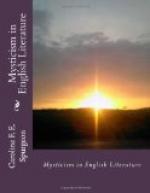That serene and blessed mood
In which ... the breath of this corporeal frame,
And even the motion of our human blood,
Almost suspended, we are laid asleep
In body, and become a living soul:
While with an eye made quiet by the power
Of harmony, and the deep power of joy,
We see into the life of things.
Tintern Abbey.
“Harmony” and “Joy,” it may be noted, are the two words used most constantly by those who have experienced this vision.
The mystic reverses the ordinary methods of reasoning: he must believe before he can know. As it is put in the Theologia Germanica, “He who would know before he believeth cometh never to true knowledge.” Just as the sense of touch is not the faculty concerned with realising the beauty of the sunrise, so the intellect is not the faculty concerned with spiritual knowledge, and ordinary intellectual methods of proof, therefore, or of argument, the mystic holds, are powerless and futile before these questions; for, in the words of Tennyson’s Ancient Sage—
Thou canst not prove the Nameless,
O my son,
Nor canst thou prove the world
thou movest in:
Thou canst not prove that
thou art body alone,
Nor canst thou prove that
thou art spirit alone,
Nor canst thou prove that
thou art both in one:
Thou canst not prove thou
art immortal, no,
Nor yet that thou art mortal—nay,
my son,
Thou canst not prove that
I who speak with thee
Am not thyself in converse
with thyself,
For nothing worthy proving
can be proven,
Nor yet disproven.
Symbolism is of immense importance in mysticism; indeed, symbolism and mythology are, as it were, the language of the mystic. This necessity for symbolism is an integral part of the belief in unity; for the essence of true symbolism rests on the belief that all things in Nature have something in common, something in which they are really alike. In order to be a true symbol, a thing must be partly the same as that which it symbolises. Thus, human love is symbolic of divine love, because, although working in another plane, it is governed by similar laws and gives rise to similar results; or falling leaves are a symbol of human mortality, because they are examples of the same law which operates through all manifestation of life. Some of the most illuminating notes ever written on the nature of symbolism are in a short paper by R. L. Nettleship,[2] where he defines true mysticism as “the consciousness that everything which we experience, every ‘fact,’ is an element and only an element in ‘the fact’; i.e. that, in being what it is, it is significant or symbolic of more.” In short, every truth apprehended by finite intelligence must by its very nature only be the husk of a deeper truth, and by the aid of symbolism we are often enabled to catch




